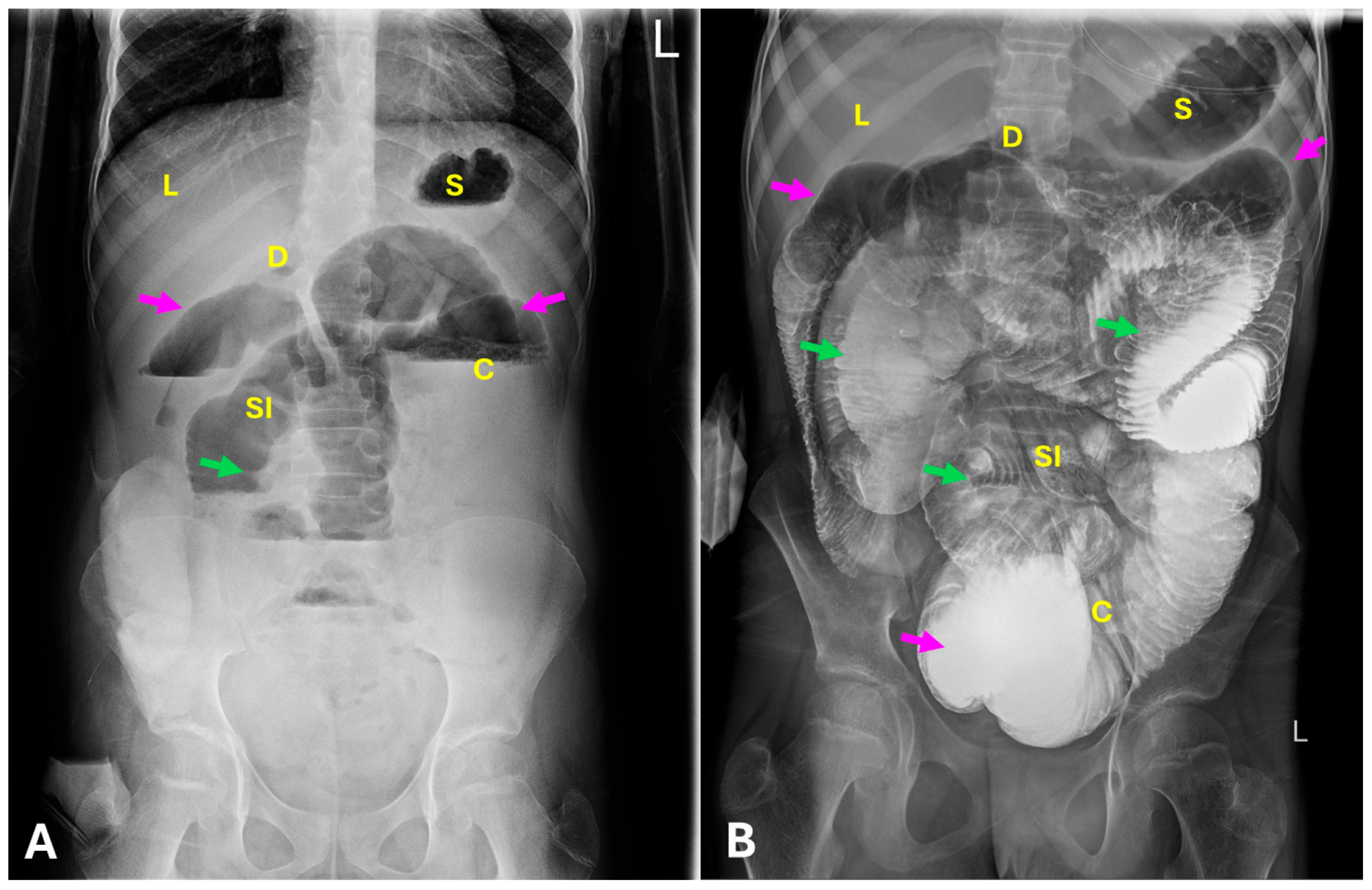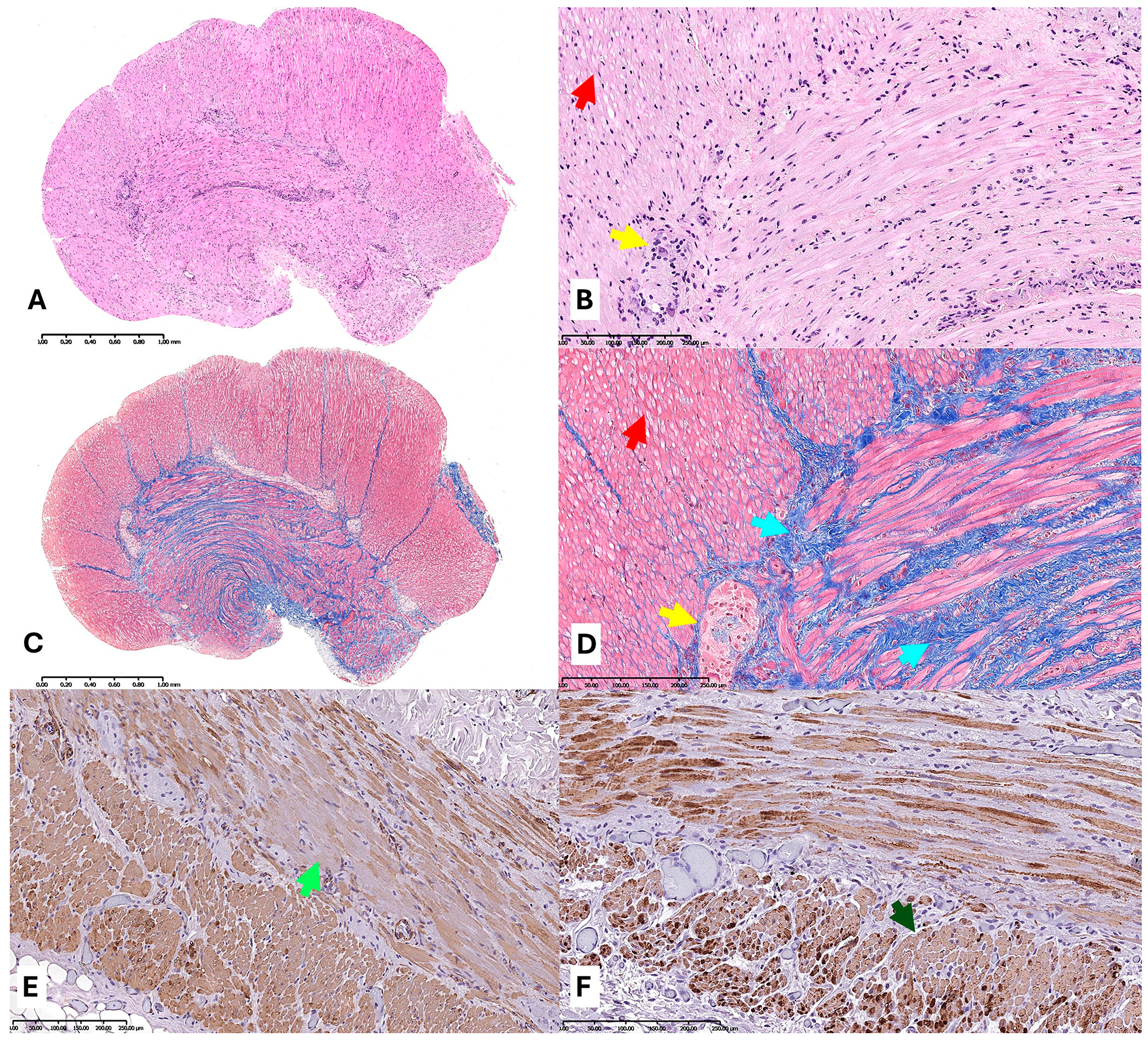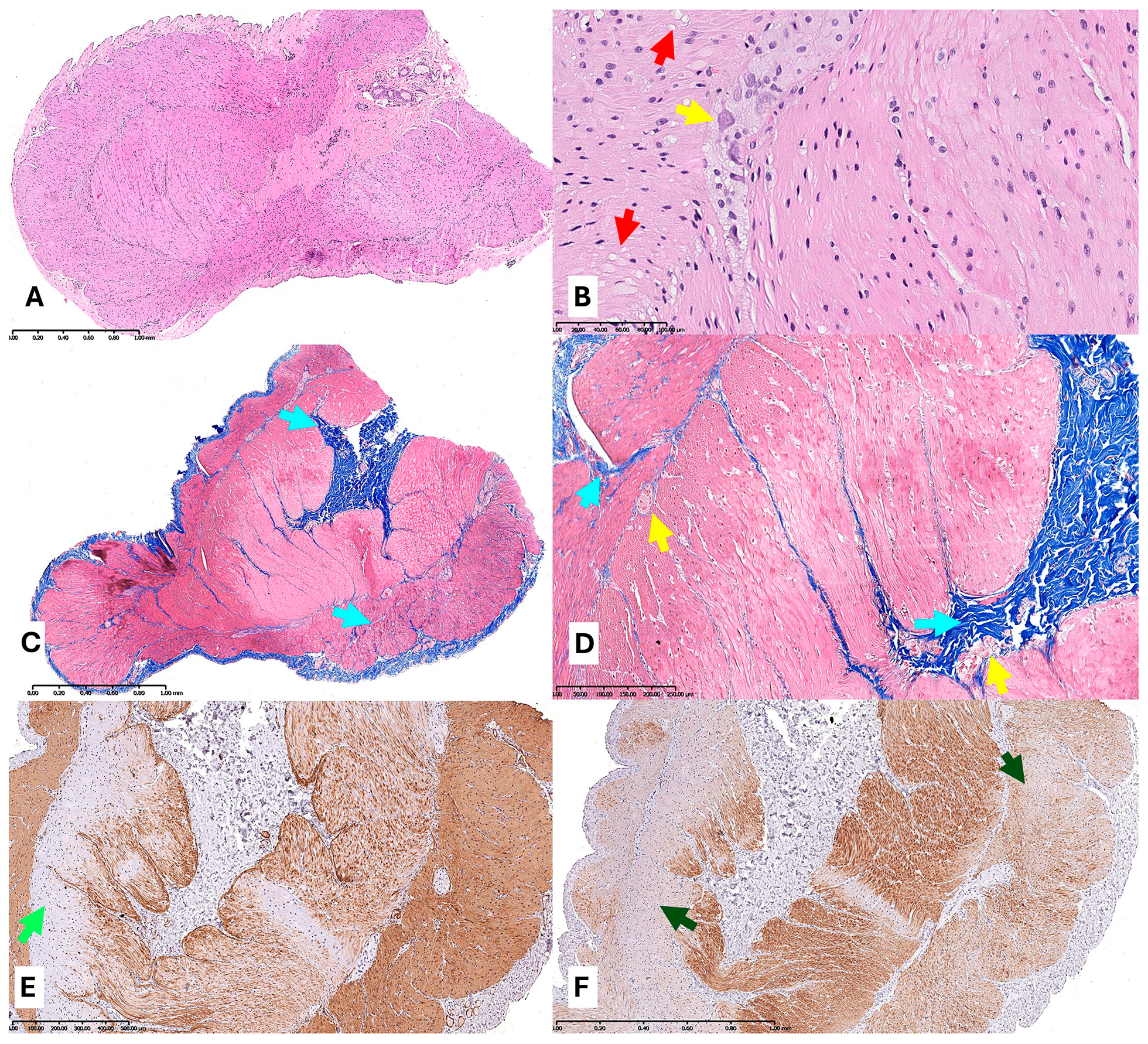Infrequent, but Not Intricate Radiological and Pathological Diagnosis of Chronic Intestinal Pseudo-Obstruction—Presented in a Two Pediatrics Cases of the Visceral Myopathy
Abstract




Author Contributions
Funding
Institutional Review Board Statement
Informed Consent Statement
Data Availability Statement
Conflicts of Interest
Abbreviations
| VM | Visceral Myopathy |
| HE | Hematoxylin and Eosin |
| TM | Trichrome-Masson |
| SMA | Smooth Muscle Actinin Immunohistochemistry |
References
- Johnson, L.N.; Moran, S.K.; Bhargava, P.; Revels, J.W.; Moshiri, M.; Rohrmann, C.A.; Mansoori, B. Fluoroscopic Evaluation of Duodenal Diseases. Radiographics 2022, 42, 397–416. [Google Scholar] [CrossRef] [PubMed]
- Rohrmann, C.A.; Ricci, M.T.; Krishnamurthy, S.; Schuffer, M.D. Radiologic and histologic differentiation of neuromuscular disorders of the gastrointestinal tract: Visceral myopathies, visceral neuropathies, and progressive systemic sclerosis. Am. J. Roentgenol. 1984, 143, 933–941. [Google Scholar] [CrossRef] [PubMed]
- Thapar, N.; Saliakellis, E.; Benninga, M.A.; Borrelli, O.; Curry, J.; Faure, C.; De Giorgio, R.; Gupte, G.; Knowles, C.H.; Staiano, A.; et al. Paediatric Intestinal Pseudo-obstruction: Evidence and Consensus-based Recommendations from an ESPGHAN-Led Expert Group. J. Pediatr. Gastroenterol. Nutr. 2018, 66, 991–1019. [Google Scholar] [CrossRef] [PubMed]
- Viti, F.; De Giorgio, R.; Ceccherini, I.; Ahluwalia, A.; Alves, M.M.; Baldo, C.; Baldussi, G.; Bonora, E.; Borrelli, O.; Dall’Oglio, L.; et al. Multi-Disciplinary Insights from the First European Forum on Visceral Myopathy 2022 Meeting. Dig. Dis. Sci. 2023, 68, 3857–3871. [Google Scholar] [CrossRef] [PubMed]
- Knowles, C.H.; De Giorgio, R.; Kapur, R.P.; Bruder, E.; Farrugia, G.; Geboes, K.; Gershon, M.D.; Hutson, J.; Lindberg, G.; Martin, J.E.; et al. Gastrointestinal Neuromuscular Pathology: Guidelines for Histological Techniques and Reporting on Behalf of the Gastro 2009 International Working Group. Acta Neuropathol. 2009, 118, 271–301. [Google Scholar] [CrossRef] [PubMed]
- Odze, R.; Goldblum, J. Surgical Pathology of the GI Tract, Liver, Biliary Tract and Pancreas, 4th ed.; Elsevier: Philadelphia, PA, USA, 2023. [Google Scholar]
- Kapur, R.P. Surgical Pathology of Primary Intestinal Myopathy. Arch. Pathol. Lab. Med. 2025. [Google Scholar] [CrossRef] [PubMed]
- Finsterer, J.; Strobl, W. Gastrointestinal Involvement in Neuromuscular Disorders. J. Gastroenterol. Hepatol. 2024, 39, 1982–1993. [Google Scholar] [CrossRef] [PubMed]
- Zhu, C.Z.; Zhao, H.W.; Lin, H.W.; Wang, F.; Li, Y.X. Latest Developments in Chronic Intestinal Pseudo-Obstruction. World J. Clin. Cases 2020, 8, 5852–5865. [Google Scholar] [CrossRef] [PubMed]
- Sanders, K.M.; Ward, S.M.; Koh, S.D. Interstitial Cells: Regulators of Smooth Muscle Function. Physiol. Rev. 2014, 94, 859–907. [Google Scholar] [CrossRef] [PubMed]
- Bianco, F.; Lattanzio, G.; Lorenzini, L.; Mazzoni, M.; Clavenzani, P.; Calzà, L.; Giardino, L.; Sternini, C.; Costanzini, A.; Bonora, E.; et al. Enteric Neuromyopathies: Highlights on Genetic Mechanisms Underlying Chronic Intestinal Pseudo-Obstruction. Biomolecules 2022, 12, 1849. [Google Scholar] [CrossRef] [PubMed]
- Al Jada, I.; Jabareen, M.; Alhroub, W.; Iwaiwi, R.; Zeidan, M.; Meshal, T. Delayed diagnosis and management of adult Hirschsprung’s disease: Case report and literature review. Int. J. Surg. Case Rep. 2025, 128, 110908. [Google Scholar] [CrossRef] [PubMed]
- Basilisco, G.; Marchi, M.; Coletta, M. Chronic intestinal pseudo-obstruction in adults: A practical guide to identify patient subgroups that are suitable for more specific treatments. Neurogastroenterol. Motil. 2024, 36, e14715. [Google Scholar] [CrossRef] [PubMed]
- Hashmi, S.K.; Ceron, R.H.; Heuckeroth, R.O. Visceral myopathy: Clinical syndromes, genetics, pathophysiology, and fall of the cytoskeleton. Am. J. Physiol. Gastrointest. Liver Physiol. 2021, 320, G919–G935. [Google Scholar] [CrossRef] [PubMed]
Disclaimer/Publisher’s Note: The statements, opinions and data contained in all publications are solely those of the individual author(s) and contributor(s) and not of MDPI and/or the editor(s). MDPI and/or the editor(s) disclaim responsibility for any injury to people or property resulting from any ideas, methods, instructions or products referred to in the content. |
© 2025 by the authors. Licensee MDPI, Basel, Switzerland. This article is an open access article distributed under the terms and conditions of the Creative Commons Attribution (CC BY) license (https://creativecommons.org/licenses/by/4.0/).
Share and Cite
Kujdowicz, M.; Drabik, G.; Młynarski, D.; Jędrzejowska, K.; Górecki, W.; Wierdak, A.; Płachno, K.; Kobos, J. Infrequent, but Not Intricate Radiological and Pathological Diagnosis of Chronic Intestinal Pseudo-Obstruction—Presented in a Two Pediatrics Cases of the Visceral Myopathy. Diagnostics 2025, 15, 2503. https://doi.org/10.3390/diagnostics15192503
Kujdowicz M, Drabik G, Młynarski D, Jędrzejowska K, Górecki W, Wierdak A, Płachno K, Kobos J. Infrequent, but Not Intricate Radiological and Pathological Diagnosis of Chronic Intestinal Pseudo-Obstruction—Presented in a Two Pediatrics Cases of the Visceral Myopathy. Diagnostics. 2025; 15(19):2503. https://doi.org/10.3390/diagnostics15192503
Chicago/Turabian StyleKujdowicz, Monika, Grażyna Drabik, Damian Młynarski, Katarzyna Jędrzejowska, Wojciech Górecki, Anna Wierdak, Kamila Płachno, and Józef Kobos. 2025. "Infrequent, but Not Intricate Radiological and Pathological Diagnosis of Chronic Intestinal Pseudo-Obstruction—Presented in a Two Pediatrics Cases of the Visceral Myopathy" Diagnostics 15, no. 19: 2503. https://doi.org/10.3390/diagnostics15192503
APA StyleKujdowicz, M., Drabik, G., Młynarski, D., Jędrzejowska, K., Górecki, W., Wierdak, A., Płachno, K., & Kobos, J. (2025). Infrequent, but Not Intricate Radiological and Pathological Diagnosis of Chronic Intestinal Pseudo-Obstruction—Presented in a Two Pediatrics Cases of the Visceral Myopathy. Diagnostics, 15(19), 2503. https://doi.org/10.3390/diagnostics15192503






